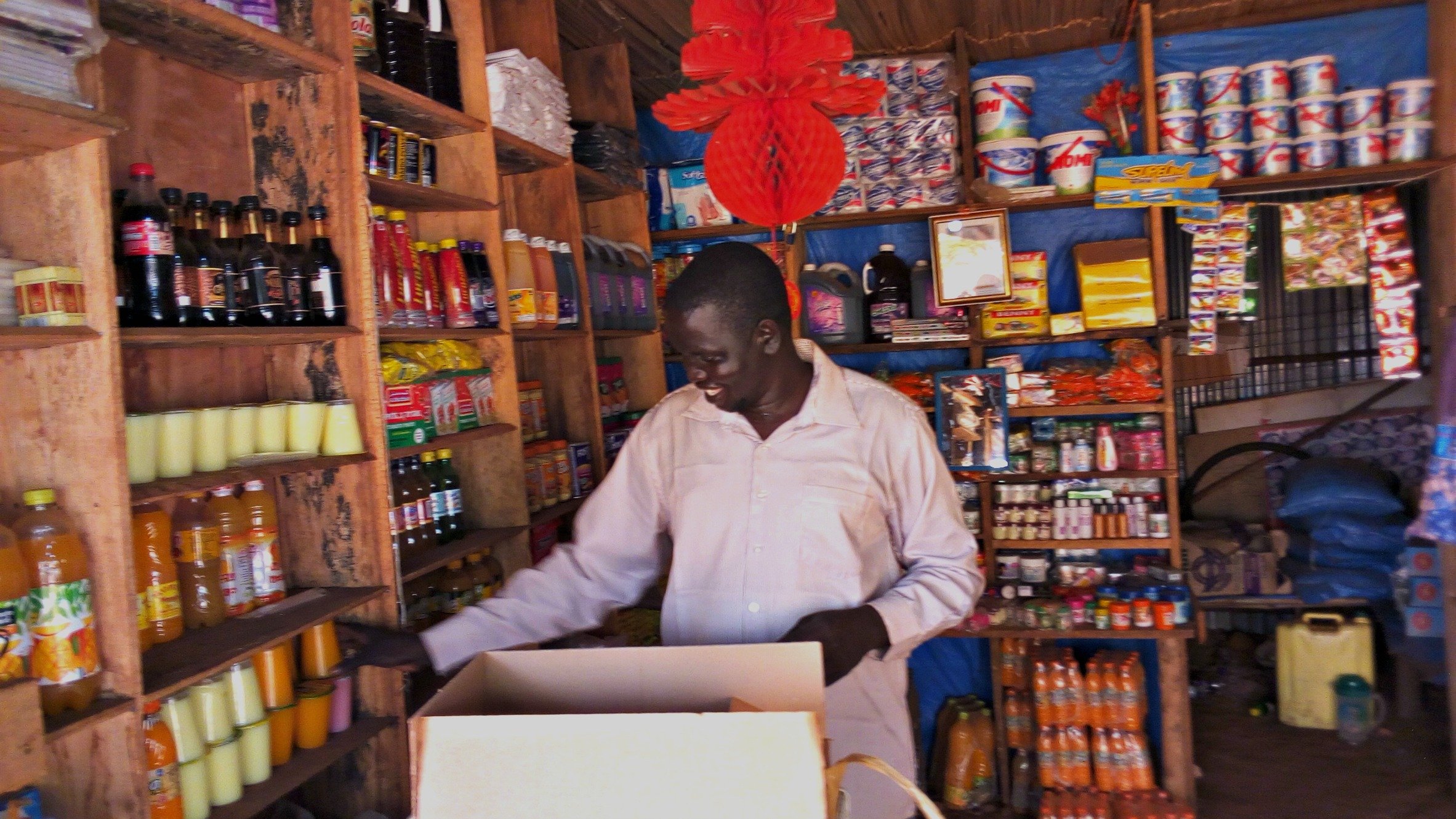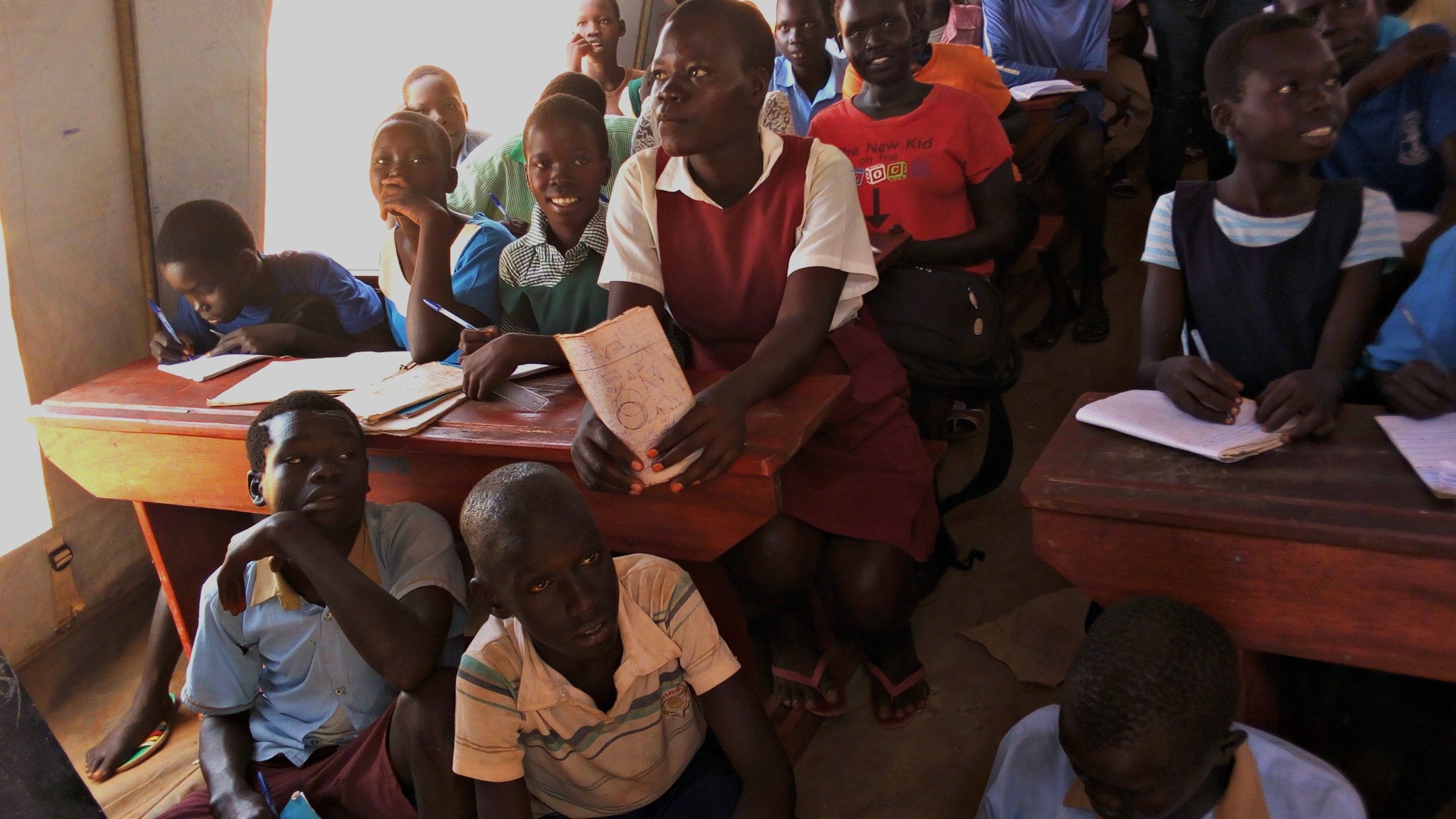South Sudanese refugee children in northern Uganda
A heady mix of Afrobeat and traditional South Sudanese folk music hangs over the jumbled stalls and makeshift corrugated iron shops that form the trading centre of Nyumanzi, a sprawling refugee settlement in northern Uganda.
Jacob Yout Achiek, 36, ignores the motorcycle hooters blaring from the dirt road winding through the booming market area as he checks the stock of soap, sugar, flour and tea in his commodities store. There isn’t much Achiek hasn’t seen or heard: women with empty stares and hollow-cheeked children are among the thousands who have been pouring into the settlement from across the nearby border with South Sudan, bearing tales of unimaginable cruelty.
They tell of hunger, torture, looting and killings; of homes torched, boys forcibly recruited to join the fighting, women and girls raped.
Conditions in South Sudan are similar to those in Rwanda in the run-up to the genocide, a special session of the United Nations human rights council was told in December.
South Africa’s Yasmin Sooka, chair of the UN Commission on Human Rights in South Sudan, said in her statement to the council that the scale of sexual violence matches that of the war in Bosnia. “A UN survey found 70% of [South Sudanese] women in the camps had been raped since the conflict erupted, the vast majority of them by police or soldiers, and a staggering 78% had been forced to watch someone else being sexually violated,” Sooka reported.
More than 383 000 people have fled to Uganda since July, when violence resumed in the South Sudanese capital of Juba, according to a statement last month to the UN Security Council from the UN’s aid chief, Stephen O’Brien. This is, on average, more than 2 400 people a day. Uganda now shelters more than 600 000 South Sudanese.

Jacob Yout Achiek left Juba three years ago. He now runs a small store in Uganda selling South Sudanese products to refugees in the community. (Mugume Davis Rwakaringi)
An obligation to ‘return the good’
Achiek is one of the veterans in Nyumanzi. He left Juba three years ago, when fighting broke out in December 2013 between forces loyal to President Salva Kiir and supporters of the opposition leader, Riek Machar.
Like many others since then, Achiek and his family made their way through heavy marshland and dense bushes, hiding from soldiers and surviving on plants. A month later he arrived with his wife and three children, then 11, 9 and 4, in Nyumanzi, a major transit centre for refugees in northern Uganda’s Adjumani district.
Achiek was given a small plot of land in the settlement and equipment to build a mud hut.
“Actually, I call Uganda my second home,” he says. “The office of the [Ugandan] prime minister is like our government. If you have a problem, you call them and they will respond immediately. There is no difference between Uganda and my country.”
The difference, though, is that Achiek and the other refugees are safe and welcome in Uganda. The Ugandan government is widely considered to have one of the most generous refugee policies in the world and the World Bank and the UN have hailed the country’s refugee policy as a model for global refugee management.
This approach is followed because Ugandans themselves have had to flee to other countries for their safety, says Godfrey Byaruhanga, co-ordinator of refugee services in Uganda’s Office of the Prime Minister. Now it is their obligation to “return the good”.
“Most of our leaders have been refugees, so it has been easy for them to embrace this refugee policy,” he says. “Refugees are human beings like me and you so they deserve the same freedoms.”
This attitude is in contrast to that of most other African countries struggling to cope with rising refugee numbers. In Kenya, home of the world’s largest and oldest refugee camp, Dadaab, refugees cannot legally work and their movements are limited. Kenya has recently warned it will close Dadaab and Kakuma, its second-largest refugee camp.
Uganda becomes continent’s third leading destination for refugees
Over the years Uganda’s generous approach has made it attractive to refugees from not only South Sudan, but also Burundi, Rwanda, Somalia and the Democratic Republic of the Congo.
Uganda is now host to nearly 900 000 refugees, according to the UN refugee agency’s 2017 response plan for refugees, making it the third-largest refugee host in Africa after Ethiopia and Kenya.
New arrivals in Uganda have freedom of movement, says Byaruhanga. Refugees have the right to work and are entitled to the same social services as locals, such as free primary education and healthcare. They are given small plots to farm in settlements scattered across northern Uganda, which the government is at pains not to call camps.
Amou Deng was pregnant with her fourth child when she started walking from Bor, nearly eight hours north of Juba, in the rainy season. She doesn’t know whether her husband is still alive because they were separated in the 2013 conflict. She reached Nyumanzi with her three children in January 2014.
Deng was taught new farming methods in a farming group. She has harvested maize and beans as well as greens such as spinach.
“Besides providing us with food, we can also sell some [vegetables] to get money for other needs,” she says.
Living in communities, not outside them
Achiek got start-up capital for his business from the humanitarian agency the Lutheran World Federation, which gives the refugees support grants in partnership with the UN refugee agency and other aid organisations. Achiek got a loan of two million Ugandan shillings ($570).
He buys traditional South Sudanese products from newly arrived refugees and Ugandan traders brave enough to venture across the nearby border. Most of his customers are Ugandans.
“This [grant] has made my business easily develop, that’s why you can see it like this,” Achiek declares, spreading his arms to indicate his stacked shelves. “This is now worth five million shillings [$1 430].”
His neighbours are Ugandan businesspeople: local traders and newcomers work side by side. The refugees are encouraged to integrate with local communities.
Achiek has gone back to school, joining his children in the settlement’s school.
Abuni Samuel is Ugandan, as are roughly half the teachers at the Nyumanzi primary school. He says the refugees have become “like brothers” and that they “have helped business in the area”.
Samuel has a point. Refugees are boosting the local economy because they get cash and land, according to a recent study by the UN World Food Programme (WFP). Researchers say refugees “benefit those countries that welcome them and give them what they need to build new lives”.
Since 2014 the food programme, the Uganda government and the UN refugee agency have distributed cash among the refugees and have now helped 650 000 people. This enables them to decide for themselves what they want to eat and boosts their buying power.
“When WFP provided cash assistance, each dollar increased real income in and around the settlements by an additional US$1 and US$1.50. And when food was provided to refugees in kind, the corresponding increase was US$1.30,” according to the study, which was released in November.

Refugee children learn alongside those from their host community in Uganda but some fear that with 70 children in a class, it is the largely South Sudanese learners who are in danger of being left behind. (Mugume Davis Rwakaringi)
Stretched to the limit?
But even the most generous and welcoming of countries would be stretched by the waves of newcomers. Samuel says it is the South Sudanese children at the Nyumanzi primary school that he worries about most. About 80% of the pupils – there are just over 1 000 children in the school – are refugees. Recently many wrote their primary school-leaving exams alongside local boys and girls.
“They sleep three or four in a room … they can’t revise properly. Then we are teaching them in two classrooms – where they are over 70 – so class management becomes difficult.”
Gabriel Major, 17, who fled his native Jonglei state with his parents in December 2013, is one of the refugees who wrote the primary school-leaving exams.
“I have no money for books,” he says matter-of-factly. “Sometimes I go for the whole day without eating.”
Winifred Kiiza, leader of the opposition in Parliament, complains that classrooms are so packed that children struggle to learn.
She claims that some refugees have had to return to South Sudan because there is simply not enough food in Uganda.
Not all Ugandans are happy with the welcome the refugees get and privately complain that the newcomers are better off than the locals.
One farmer warns there will not be any land left for Ugandans.
Where only five months ago there were swaths of rough grassland around the small town of Bidi Bidi in northern Uganda, the world’s fourth-biggest refugee camp there has mushroomed. The settlement has already reached maximum capacity with a population of more than 220 000, the UN refugee agency said in November.
A staggering 86% of the new arrivals are women and children, with little means to support themselves.
Food rations have been cut to those who arrived before 2015 and plot sizes have been halved.
Many refugees say there are no long-term solutions. Deng says her piece of land is not big enough to plant enough food to become self-sufficient.
She believes she has no choice but to stay in Uganda. She has no husband and no home in South Sudan – and everything to fear.
– Additional reporting by Adri Kotze.
This is the first of a two-part series on refugees in Uganda.